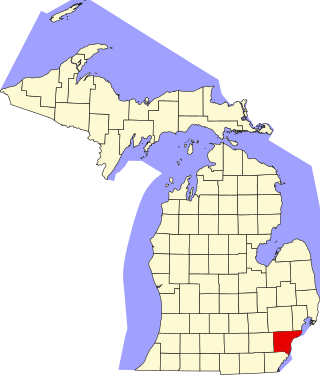
This is a list of the National Register of Historic Places listings in Wayne County, Michigan.

The Central Avenue Corridor is a significant stretch of north–south Central Avenue in Phoenix, Arizona. Roughly bounded by Camelback Road to its north, and McDowell Road to its south, this is one of Phoenix's most vital and heavily trafficked stretches of roads. It is also one of the region's largest centers of employment, with nearly 60,000 people being employed within a three-mile (5 km) radius of this swath of Central Avenue. Major employers here include major banks and financial institutions, hi-tech companies, and several significant law firms and government agencies.

The Whitney Avenue Historic District is a historic district in the East Rock neighborhood of New Haven, Connecticut. It is a 203-acre (82 ha) district which included 1,084 contributing buildings when it was listed on the National Register of Historic Places in 1989.

Hyde School is a historic Romanesque Revival school at 130 High Street in Lee, Massachusetts. The school was built in 1894 from locally quarried marble. It is named for Alexander Hyde, who established the town's first school in his house on West Park Street, and was built on the site of the town's first public school.

Starrett & van Vleck was an American architectural firm based in New York City which specialized in the design of department stores, primarily in the early 20th century. It was active from 1908 until at least the late 1950s.

There are eight properties listed on the National Register of Historic Places (NRHP) in Linn County, Kansas. Two of the sites are the location of historic events. The Marais des Cygnes Massacre Site is the location of the Marais des Cygnes massacre, an 1858 event during Bleeding Kansas in which pro-slavery advocates kidnapped 11 anti-slavery settlers, killing five of them. John Brown temporarily used the site as a fort, and the property was listed on the NRHP in 1971. The Battle of Mine Creek Site preserves the location of the Battle of Mine Creek, which was fought in 1864 as part of Price's Raid during the American Civil War. Confederate general Sterling Price's army was retreating after being defeated at the Battle of Westport and was attacked by pursuing Union troops. Price's Confederate lost heavily in men and supplies. The site was added to the NRHP in 1973.
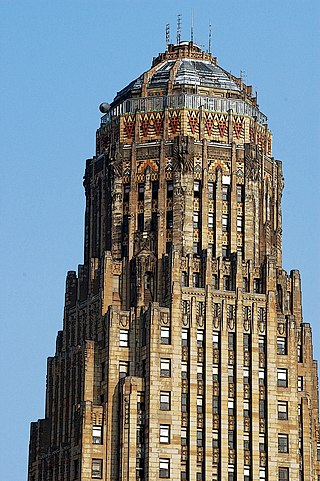
The Architecture of Buffalo, New York, particularly the buildings constructed between the American Civil War and the Great Depression, is said to have created a new, distinctly American form of architecture and to have influenced design throughout the world.
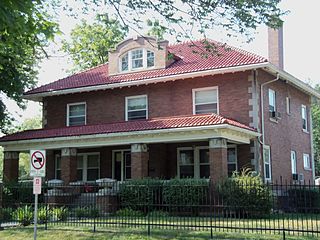
The Arthur Ebeling House is a historic building located on the west side of Davenport, Iowa, United States. The Colonial Revival house was designed by its original owner, Arthur Ebeling. It was built from 1912 to 1913 and it was listed on the National Register of Historic Places in 1984.
The Grand Forks Near Southside Historic District is a 182-acre (74 ha) historic district in Grand Forks, North Dakota that was listed on the National Register of Historic Places (NRHP) in 2004.
Esenwein & Johnnson was an architectural firm of Buffalo, New York.

Monarch Engineering Co. was an American firm of Denver, Colorado, active in engineering and construction services. John A. Crook and his brother, Guy A. Crook of Falls City, were founders of the Monarch Engineering company which had its origin and main offices at Falls City, with offices in Kansas City, and Denver. Under the management of these men the Monarch Engineering company had risen to become an important and prosperous concern and a vast amount of bridge construction, city paving, irrigation-dam building, and public building work has been done under their supervision. Within ten years after the firm had been in operation, or since 1908, its activities constantly increased and in 1917 they purchased the Denver Steel and Iron Works in order to facilitate the material supply part of the construction work in which they were engaged.
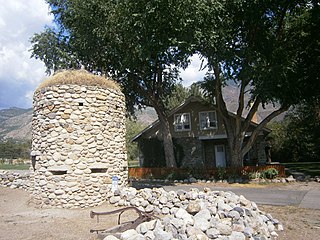
The Moyle House and Indian Tower is a historic residence and watchtower in Alpine, Utah, United States, that is listed on the National Register of Historic Places.
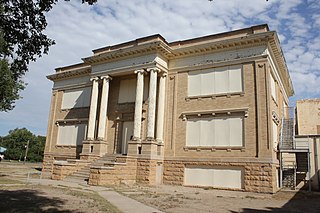
The Bent County High School, in Bent County, Colorado at 1214 Ambassador Thompson Blvd in Las Animas, is a historic school that was built in 1913 or 1914. It has been deemed notable for association with former U.S. Ambassador Llewellyn Thompson, Ken Curtis, and author James Michener’s wife, Mari (Sabusawa) Michener, all of whom attended the school, as well as for "its imposing, three-story, massive-columned architecture". It was designed by Swedish architect James Larson. The building was listed on the National Register of Historic Places (NRHP) in 2010.

St. Andre's Parish is a former parish of the Roman Catholic Diocese of Portland, located on Bacon and Sullivan Streets in Biddeford, Maine, USA. The parish was founded in 1860 to serve the city's large French-Canadian and French-American communities. On July 1, 2008, St. Andres was merged into the newly formed Good Shepherd Parish. The parish complex of four buildings, including the church, rectory, convent and school, was listed on the National Register of Historic Places in 2015, at which time most of it stood vacant.

The Ludlow Graded School is a historic former school building at 10 High Street in the village of Ludlow, Vermont. Built in 1871–72, the school was for many years the primary school feeding the adjacent Black River Academy. The building now serves as a local senior services center. It was listed on the National Register of Historic Places in 1979.

The Joshua Twing Gristmill is a historic industrial facility at 450 North Main Street in the city of Barre, Vermont. Built in 1844, it is a remarkably high-style example of Greek Revival architecture for an essentially utilitarian industrial structure. Joshua Twing, its builder, was engaged for many years in a variety of industrial pursuits, primarily considered with engineering improvements in water wheels and turbines. The building was listed on the National Register of Historic Places in 1978.
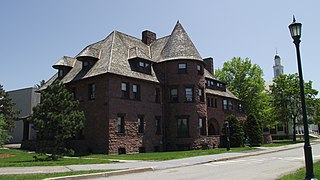
Redstone is a historic former estate on South Prospect Street in Burlington, Vermont. It was developed in 1889, and includes some of Burlington's finest examples of Richardsonian Romanesque, Shingle, and Colonial Revival architecture. Its surviving elements are Redstone Green and some of its surrounding buildings on the campus of the University of Vermont, which acquired the property in 1921, and are part of the university's Redstone Campus. It was listed on the National Register of Historic Places in 1991 as the Redstone Historic District.
Gustav A. Hanssen was an American architect. He designed private residences in Davenport, Iowa and later moved to San Diego, California. Several of his buildings are listed on the National Register of Historic Places (NRHP).
The University Neighborhood Historic District is a 180 acres (73 ha) historic district near the University of Utah campus in northeastern Salt Lake City, Utah, United States, that was listed on the National Register of Historic Places in 1995.


















